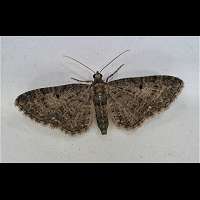Golden-rod Pug Eupithecia virgaureata
The Golden-rod Pug is a very difficult species to identify. The markings are quite unremarkable and it is extremely similar to the Grey Pug. Experienced moth experts usually are able to tell most specimens apart. The dark spot in the wings, called the discal spot, usually is rounder in the Golden-rod Pug. The Grey Pug's discal spot usually is more of a small line. The Golden-rod Pug normally is more vividly marked than the Grey Pug is. However when you have no experience with these two species, the only way of telling them apart is by examining the genitals. The females especially are extremely difficult to name. Even the size is about the same in both species: their wingspan ranges from 17 to 22mm.
The second generation of adults deposits the eggs on blackthorn and hawthorn. These caterpillars will bring forward the first generation of moths flying about in April and May. The adults of the first generation deposit their eggs on many plants, including Golden-rod, heath, Wild Heather and groundsel. The larvae eating these plants grow very fast to deliver the second brood from July onwards to half August. The caterpillar is brown with black triangular markings and a wavy light line on each side. It pupates in or just above the ground and reaches a length of some 20mm.
The Golden-rod Pug is on the wing in April and May and then again in July and August. It is attracted to light in very small numbers only. Resident species in Northern and Western England and Wales. Scarce in Southern and Eastern England. A local species in lowland Scotland and Ireland. Prefers woodlands on sandy soils. This species is widely distributed in Europe, temperate Asia and Japan.
The Golden-rod Pug is a very difficult species to identify. The markings are quite unremarkable and it is extremely similar to the Grey Pug. Experienced moth experts usually are able to tell most specimens apart. The dark spot in the wings, called the discal spot, usually is rounder in the Golden-rod Pug. The Grey Pug's discal spot usually is more of a small line. The Golden-rod Pug normally is more vividly marked than the Grey Pug is. However when you have no experience with these two species, the only way of telling them apart is by examining the genitals. The females especially are extremely difficult to name. Even the size is about the same in both species: their wingspan ranges from 17 to 22mm.
The second generation of adults deposits the eggs on blackthorn and hawthorn. These caterpillars will bring forward the first generation of moths flying about in April and May. The adults of the first generation deposit their eggs on many plants, including Golden-rod, heath, Wild Heather and groundsel. The larvae eating these plants grow very fast to deliver the second brood from July onwards to half August. The caterpillar is brown with black triangular markings and a wavy light line on each side. It pupates in or just above the ground and reaches a length of some 20mm.
The Golden-rod Pug is on the wing in April and May and then again in July and August. It is attracted to light in very small numbers only. Resident species in Northern and Western England and Wales. Scarce in Southern and Eastern England. A local species in lowland Scotland and Ireland. Prefers woodlands on sandy soils. This species is widely distributed in Europe, temperate Asia and Japan.




